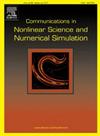Thermal and entropy analysis of ternary hybrid nanofluid using Keller Box method
IF 3.4
2区 数学
Q1 MATHEMATICS, APPLIED
Communications in Nonlinear Science and Numerical Simulation
Pub Date : 2024-09-28
DOI:10.1016/j.cnsns.2024.108366
引用次数: 0
Abstract
This research investigates the flow and heat transfer characteristics of a ternary hybrid nanofluid in a rotating system between two parallel stretching surfaces. It examines the impact of nanoparticle shape factor and irreversibility on suspensions containing AlO, CuO, and ZnO nanoparticles in water. Different physical and thermal conditions are taken into account, such as porous medium, suction/injection, radiation, heat source/sink, variable viscosity and thermal conductivity. Ternary hybrid nanofluids exhibit better thermophysical stability and performance than traditional nanofluids. The application of ternary hybrid nanofluids in rotating systems with two parallel stretching surfaces has industrial applications such as material treatment, manufacturing processes, and cooling systems. By introducing similarity variables, the governing partial differential equations are transformed into ordinary differential equations, which are then solved numerically using the Keller Box Method based on implicit finite differences. The study finds that as the viscosity parameter increases, there is a decrease in fluid velocity and an increase in temperature. Additionally, increasing values of radiation and thermal conductivity parameter lead to enhanced temperature and entropy generation rate. The entropy generation rate is higher for platelet-shaped nanoparticles and lower for spherical-shaped nanoparticles. Platelet shapes exhibit lower friction during suction and injection, while spherical shapes exhibit higher friction. Furthermore, the heat transfer rates of ternary hybrid nanofluids containing sphere, brick, cylinder, platelet, and blade-shaped nanoparticles suspended in water are 3.27%, 6.41%, 11.14%, 13.56%, and 14.20%, respectively, when injection is performed at the top surface of the sheet. For suction, the heat transfer rates are 16.91% for the sphere, 19.48% for the brick, 23.83% for the cylinder, 26.84% for the platelet, and 39.69% for the blade.
利用凯勒方框法分析三元混合纳米流体的热量和熵值
本研究探讨了三元混合纳米流体在两个平行拉伸表面之间的旋转系统中的流动和传热特性。研究考察了纳米颗粒形状系数和不可逆性对水中含有 Al2O3、CuO 和 ZnO 纳米颗粒的悬浮液的影响。研究考虑了不同的物理和热条件,如多孔介质、吸入/注入、辐射、热源/散热、可变粘度和热导率。与传统纳米流体相比,三元混合纳米流体表现出更好的热物理稳定性和性能。三元混合纳米流体在具有两个平行拉伸表面的旋转系统中的应用可用于材料处理、制造工艺和冷却系统等工业领域。通过引入相似变量,将控制偏微分方程转化为常微分方程,然后使用基于隐式有限差分的 Keller Box 方法对其进行数值求解。研究发现,随着粘度参数的增加,流体速度会降低,温度会升高。此外,辐射和导热参数值的增加也会导致温度和熵产生率的增加。血小板形纳米粒子的熵产生率较高,而球形纳米粒子的熵产生率较低。在吸入和注入过程中,板状纳米粒子的摩擦力较小,而球状纳米粒子的摩擦力较大。此外,悬浮在水中的球形、砖形、圆柱形、板形和叶片形纳米粒子的三元混合纳米流体的传热率分别为 3.27%、6.41%、11.14%、13.56% 和 14.20%。在吸热方面,球形的传热率为 16.91%,砖形的传热率为 19.48%,圆柱形的传热率为 23.83%,平板形的传热率为 26.84%,叶片形的传热率为 39.69%。
本文章由计算机程序翻译,如有差异,请以英文原文为准。
求助全文
约1分钟内获得全文
求助全文
来源期刊

Communications in Nonlinear Science and Numerical Simulation
MATHEMATICS, APPLIED-MATHEMATICS, INTERDISCIPLINARY APPLICATIONS
CiteScore
6.80
自引率
7.70%
发文量
378
审稿时长
78 days
期刊介绍:
The journal publishes original research findings on experimental observation, mathematical modeling, theoretical analysis and numerical simulation, for more accurate description, better prediction or novel application, of nonlinear phenomena in science and engineering. It offers a venue for researchers to make rapid exchange of ideas and techniques in nonlinear science and complexity.
The submission of manuscripts with cross-disciplinary approaches in nonlinear science and complexity is particularly encouraged.
Topics of interest:
Nonlinear differential or delay equations, Lie group analysis and asymptotic methods, Discontinuous systems, Fractals, Fractional calculus and dynamics, Nonlinear effects in quantum mechanics, Nonlinear stochastic processes, Experimental nonlinear science, Time-series and signal analysis, Computational methods and simulations in nonlinear science and engineering, Control of dynamical systems, Synchronization, Lyapunov analysis, High-dimensional chaos and turbulence, Chaos in Hamiltonian systems, Integrable systems and solitons, Collective behavior in many-body systems, Biological physics and networks, Nonlinear mechanical systems, Complex systems and complexity.
No length limitation for contributions is set, but only concisely written manuscripts are published. Brief papers are published on the basis of Rapid Communications. Discussions of previously published papers are welcome.
 求助内容:
求助内容: 应助结果提醒方式:
应助结果提醒方式:


